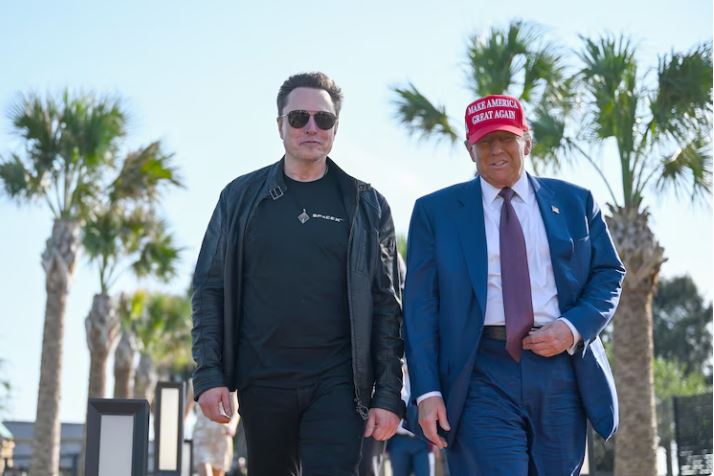President Trump declares: ‘The US will take over the Gaza Strip’
President Donald Trump has vowed that the United States will “take over” the Gaza Strip.

On Tuesday night (February 4), the 78-year-old leader held a press conference alongside Israeli Prime Minister Benjamin Netanyahu to discuss the second phase of the ceasefire between Israel and Hamas.
During the talks, Trump suggested that the US should take control of the Gaza Strip, a 41km (25-mile) long and 10 km-wide territory between Israel, Egypt, and the Mediterranean Sea.
The Gaza Strip is home to nearly 2 million people. It is largely populated by Palestinians living in refugee camps, many of whom were displaced from other parts of the region.
“We’ll own it and be responsible for dismantling all of the dangerous unexploded bombs and other weapons on the site, level the site, and get rid of the destroyed buildings – level it out and create an economic development that will supply unlimited numbers of jobs and housing for the people of the area,” Trump said, cited by The New York Post.
As for the roughly two million Palestinians currently living there, Trump stated they would be moved to neighboring countries as part of a transitional phase, but strongly suggested they would not be allowed to return.
“Just can’t go back. If you go back, it’s going to end up the same way it has for 100 years,” Trump insisted.

The two-time leader, who said he would deploy US troops to the territory “if it’s necessary,” also envisioned a complete transformation of Gaza.
He said “the world’s people” could move in and create “an international unbelievable place” that he predicted would become “the Riviera of the Middle East”.
While Netanyahu did not explicitly commit to the plan, he praised the president’s approach. “I think it’s something that could change history and it’s worthwhile really pursuing this avenue,” Netanyahu said.
The Israeli leader said: “[Trump] sees a different future for that piece of land that has been the focus of so much terrorism, so many attacks against us, so many trials and so many tribulations.
“He has a different idea, and I think it’s worth paying attention to this,” he added.
Despite the grand vision, Trump did not provide a timeline for either the US occupation or the relocation of Gaza’s residents.
However, he insisted that his plan was well thought out and had received backing from regional leaders.
“I’ve studied this very closely over a lot of months, and I’ve seen it from every different angle,” Trump stated. “I spoke to other leaders of countries in the Middle East and they love the idea. They say it really brings stability and what we need is stability.”

For generations, Palestinians have carried the weight of the “Nakba” – or “catastrophe” – when 700,000 people were uprooted from their homes during the 1948 war surrounding Israel’s creation.
Many fled to neighboring countries like Jordan, Syria, and Lebanon, where generations remain in refugee camps, while others ended up in Gaza. To this day, Israel disputes claims that they were forcibly removed.
Decades later, in the 1967 Mideast war, Israel took control of Gaza, the West Bank, and East Jerusalem – territories Palestinians envision as part of their future state.
While Israel withdrew its troops from Gaza in 2005, it retained control over its borders, coastline, and airspace. When Hamas took power in 2007, Israel imposed a blockade, triggering years of conflict.
The latest wave of violence erupted on October 7, 2023, when Hamas fighters stormed into Israel, killing approximately 1,200 people and taking 250 hostages. Israel retaliated by killing more than 46,600 people in Gaza – many of whom were women and children.
A ceasefire now holds, but for how long remains uncertain.

Trump’s plans to forcibly relocate Gaza’s population, which is nearly 2 million people, would likely violate international law and face strong opposition from both neighboring countries and America’s Western allies.
Some human rights groups also contended that such a move could amount to “ethnic cleansing”, which is the systematic forced removal of ethnic, racial, or religious groups from a given area.
Both Egypt and Jordan have already rejected Trump’s calls to accept Palestinian refugees, however, the president dismissed their concerns, claiming that he believes they will “agree to do it” and that Palestinians would welcome the relocation.
“Gaza is a hellhole right now,” he said. “It was before the bombing started, frankly, and we’re going to give people a chance to live in a beautiful community that’s safe and secure, and I think you’re going to see a tremendous outpouring of support.”
Saudi Arabia – widely regarded as Trump’s closest ally in the Gulf – also firmly rejected the forced displacement of Palestinians on Wednesday, per Financial Times. The kingdom made it clear that it would not engage in peace talks with Israel unless an independent Palestinian state was established.
While details remain vague, Trump left little doubt that he sees a long-term role for the US in the Gaza Strip. “I do see a long-term ownership position,” he said when asked about a potential U.S. takeover.
“Everybody I’ve spoken to loves the idea of the United States owning that piece of land, developing and creating thousands of jobs with something that will be magnificent, in a really magnificent area that nobody would know,” he added.





